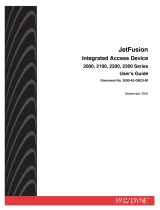
SG2126-3
Design Challenges
Media gateway implementations are
complicated by the wide variety of
technologies that make up existing
networks. These include the circuit-
switched PSTN, ATM and Frame Relay
based public data networks, and the IP-
based Internet, all of which may be
carried over the same SONET transport
network.
Functions required of media gateways
typically include the conversion (and
compression) of time-division-
multiplexed (TDM) voice circuits onto
ATM networks using a variety of
adaptation protocols (AAL-0, AAL-1,
AAL-2 and AAL-5), or onto packet-based
networks using IP (including RTP), frame
relay, or extensions of both. Voice
switches that support the switching of
voice circuits among the various network
interfaces may require interworking
between different protocols (such as
between ATM and IP-based networks)
as well.
The specific design challenges for media
gateways include:
> Accommodating increasing numbers
of voice (or fax and modem) circuits
per slot within a specific networking
device.
> Supporting the increasing number of
different network interfaces and
speeds required, ranging from
channelized T1/E1 lines through
OC-12 SONET and Gigabit Ethernet
interfaces.
> Adapting to the number of different
protocols used (such as ATM AAL-2/
AAL-5, VoIP/RTP, Packet-over-
SONET/PPP, MPLS, and so on), even
as the protocol standards evolve and
improve.
> Managing quality of service (QoS) to
ensure prioritization of latency-
sensitive traffic, such as voice.
> Providing the flexibility to add new
features and functions through
software as market demands dictate
in the future.
Freescale Semiconductor Solution
Freescale Semiconductor® offers
complete solutions for all aspects of
media gateway and switch
implementations. This includes the
StarCore® digital signal processors
(DSPs) required to convert and
compress TDM voice circuits into packet
or cell-based flows, the C-Port™ network
processors (NPs) required to terminate
or switch the packet or cell-based
circuits, and the PowerPC® ISA host
processors required to implement the
control functions that manage each voice
connection. The network processing
function is the focus of this document.
Freescale Semiconductor’s C-Port
family, including network processors,
traffic management coprocessors, and
interface adaptors, provides the flexibility
to support the wide range of protocols
required for today’s media gateway
implementations. The internal
processing resources of the C-3e NP are
particularly well suited to be used at the
“uplink” aggregation level in media
gateway designs, where extensive
protocol conversion and switching
functions are required.
The figure illustrates a VoIP/VoATM
network and details the tasks handled by
the NP. On one side of the gateway,
TDM traffic converted and compressed
by Freescale Semiconductor DSPs is
aggregated on to high density line cards
(capable of supporting 2000 voice
channels per line card with the C-3e NP,
and over 8000 with the C-5e NP) and
then passed on to an internal Ethernet
bus (or other media).
These newly created packets are
forwarded to the C-3e NP, which formats
the voice packets into the desired
network protocol, which may include IP
and ATM. With IP, the voice packet is
formatted into a specific VoIP protocol
(such as RTP), possibly tagged as part
of an MPLS session, and forwarded onto
an IP-based network (over Ethernet or
SONET), where QoS may be
guaranteed through the use of various
protocols including DiffServ.
Freescale Ordering Information
Part Number Product Highlights Additional Information
PCC3E0RX180WB0B C-3e NP 5.5 W @ 180 MHz
freescale.com/networkprocessors
PCC5E0RX266WB0B C-5e NP 9 W @ 266 MHz
freescale.com/networkprocessors
PCQ500RX000WA0A Q-5 TMC 5Gbps throughput
freescale.com/networkprocessors
MPC8260
PowerQUICC
TM
ISA
freescale.com/PowerQUICC
MSC8101
MSC8102
DSP Farm freescale.com/DSP
CSTC501W
Note 1
C-Ware Software Toolset Web site download of current CST release (Windows or UNIX)
CDEV101A
Note 2
C-Ware Development System CDS Base Unit (Chassis, Power Supply, Single Board Computer)
Notes:
1. The CST can be downloaded from freescale.cportcorp.com/support.
2. Ask your sales representative or distributor for details and availability of system modules, which you order separately.






